Aluminum foil is a common kitchen item used to seal in food’s moisture and keep it warm, but it isn’t always the most convenient choice.
In many cases, aluminum foil has properties that lend itself to being an excellent and practical food storage wrap — from providing an airtight seal to being able to withstand oven temperatures and freezer temperatures.
However, for some items or cooking methods, aluminum foil may not be the best option.
If you need an alternative to aluminum foil for any reason – such as a health concern or if you are trying to reduce waste – there are several useful substitutes available.
In this article, we will discuss five popular substitutes for aluminum foil and the various situations in which they can be used.
What is Aluminum Foil?

Aluminum foil is a thin sheet of aluminum, typically about 0.2 mm thick, that is primarily used around the kitchen to contain food, keep food warm and to create baked dishes.
It is also used by some people in larger pieces to line grill grates when they are cooking and to help amplify heat.
Aluminum foil can be used multiple times and then recycled.
Because it is a thin sheet, aluminum foil can easily tear or puncture and holds less heat than other materials such as glass or ceramic dishes.
The sheets of aluminum act as good conductors for heat so if it comes into contact with something hot it can cause the transfer of heat more quickly than other materials and potentially burn those who use them for cooking recipes.
For this reason, many people choose to avoid using aluminum foil for certain tasks in the kitchen, particularly when handling hot food items or for dishes that involve baking.
How to Use Aluminum Foil?
Aluminum foil is a thin, malleable metal sheet that has many uses in the home and commercial kitchens.
It is often used to cover pots, pans and baking dishes to prevent burning or sticking, insulate casseroles while they are being cooked, and store foods in order to keep them fresh.
To prevent food from sticking to aluminum foil (especially when cooking something with cheese), it should be sprayed or greased lightly before use.
However, while aluminum foil is great for many kitchen tasks, it can be toxic when heated in the oven or microwave due to leaching of metals into your food.
As an alternative method, consider substituting aluminum with non-toxic materials like parchment paper, wax paper or freezer paper.
5 Best Aluminum Foil Substitutes to Consider
versatile nature and malleability make it useful for a variety of storage and cooking techniques, from wrapping food for grinding in a meat grinder to steaming vegetables.
However, there are some disadvantages to using aluminum foil that can lead to the need for aluminum foil substitute products.
These include the potential health risks associated with using the product and environmental concerns about how its production impacts our planet.
Fortunately, there are several aluminum foil substitutes available for you to consider so that whatever your need, there’s a great fit out there.
Below are five of the best alternatives available:
1 – Parchment Paper
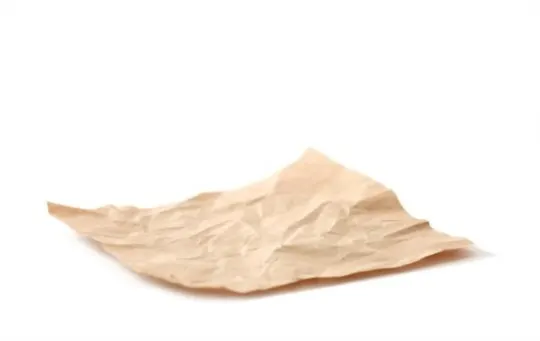
Parchment paper differs from aluminum foil in that it is a chemically treated paper, while foil is a thin sheet of metal.
It’s naturally non-stick and grease-resistant.
It’s also an excellent heat conductor and can be used to bake anything from pizza to fish.
Parchment paper comes in a variety of sizes and shapes including round, square, rectangle and pre-cut circles.
It can also be used as an excellent wrapping material for leftovers since it forms an airtight seal when heated.
Parchment paper also degrades much more quickly than aluminum foil so it has the environmental advantage of being easily compostable.
2 – Silicone Baking Sheets
Silicone baking sheets, sometimes referred to as cooking mats, are an effective and versatile alternative to aluminum foil.
They can be used in place of aluminum foil in a variety of baking methods including baking cookies and roasting vegetables.
Unlike aluminum foil, they can easily be reused time and time again without losing their integrity as a liner.
Silicone baking sheets are also nonstick, have excellent thermal stability over safe temperatures (up to 428°F) and are an excellent insulator.
Because it repels water on its own surface, silicone baking sheets don’t need to be sprayed with cooking oil or another type of lubricant before use; the non-stick quality helps food cakes, meats and other cooked items release much easier than on other types of surfaces.
As an added bonus, silicone baking sheets come in a variety of colors – from basic black to many vibrant colors – providing an additional element of style when preparing your favorite recipes.
3 – Wax Paper
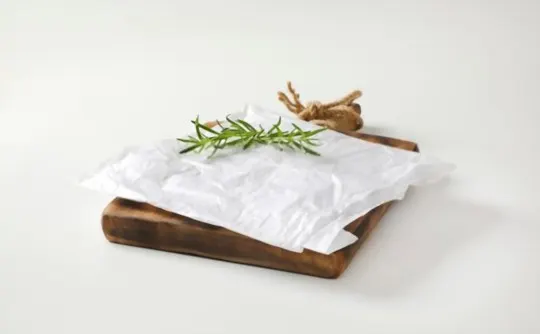
Wax paper is made of wax and paper, and it’s slowly becoming more popular in the kitchen.
Wax paper is perfect when you need a little extra heat protection or an easy-to-peel finish when wrapping foods.
It has a creamy, oily texture that can be used for cooking, baking or even as a barrier between cutlery and microwaved food.
Not all wax paper can handle going in both the oven and microwave so make sure to read the label carefully before you buy.
Wax paper also works great for making parchment wraps for grilled food.
4 – Cedar Wraps (for grilling)
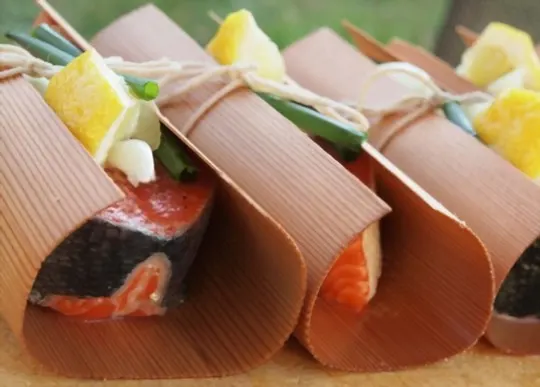
Cedar wraps are perhaps one of the oldest alternatives to aluminum foil, having been a staple of indigenous peoples for centuries.
Made from sustainably harvested cedar trees, cedar wraps come in many different shapes and sizes to suit your grilling needs.
Cedar wraps can hold all kinds of ingredients, from vegetables and seafood to poultry, beef, and pork.
They give delicate pieces of meat or fish an intense smoky flavor, infusing them with rich aromatics and hefty nutritional benefits—notably, cedar’s high levels of anti-inflammatory properties.
Thanks to the tight seal created by the wrap itself, moisture is both sealed in and kept out—keeping food succulent while it grills over open flames or crisps up on a stovetop grill pan.
Best used on foods with thicker surfaces (like thick steaks or whole fish) or placed over ingredients that need some intense smokey flavor (think ribs), cedar wraps are perfect for both indoor and outdoor cooking methods.
5 – Beeswax Food Wraps
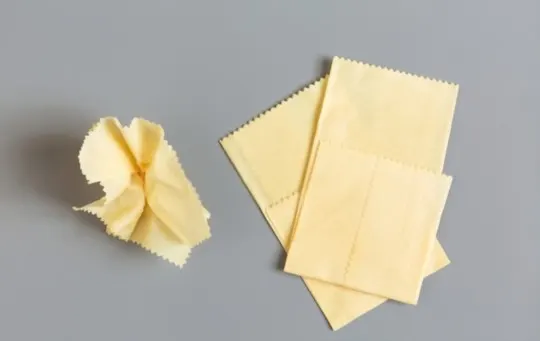
Beeswax Food Wraps are a great alternative to aluminum foil that can be used to keep food fresh and free of contaminants.
They are made of 100% pure beeswax, organic jojoba oil, and tree resin which helps to create a natural barrier around the food.
This combination makes the wrap air tight so that it keeps moisture out and allows you to store foods for longer periods of time without loss of freshness.
Additionally, these wraps are naturally anti-bacterial, helping to keep your food safe from bacteria growth.
Beeswax wraps can typically be reused about 50-100 times with care before needing replaced and can easily last up to 12 months stored in the fridge or freezer for maximum shelf life.
Additionally, beeswax wraps are malleable enough that they can be molded around different shapes or sizes of foods or containers.
For best results, use cold running water and mild soap without any abrasives when cleaning your beeswax food wrap before use or storage in order to avoid damaging it.
Conclusion
Aluminum foil is a common kitchen staple, but there are plenty of alternatives available.
From parchment paper to wax paper and even newspaper, you can find similar solutions for many of the same uses.
Before you reach for the aluminum foil, think about what the substitute would be ideal for and make sure to factor in any necessary changes in cooking techniques.
All of these substitutes have their own unique properties and applications — find out what works best for your needs.
No matter which option you choose, it’s important to remember that none of these materials are suitable replacements when it comes to grilling or high-heat application as they may not be able to withstand extended exposure to high temperatures without burning or melting.
As with any kitchen product, it’s best to focus on safety first and use common sense practices when using alternatives such as storing them away from moisture and heat exposure.
So don’t forget that there are other options besides aluminum foil.
Frequently Asked Questions
What is Aluminum Foil?
Aluminum foil is a thin sheet of aluminum metal that is used in a variety of applications, from cooking to packaging food.
It is a versatile material that can be used to wrap food and keep it fresh, as well as to line pans when cooking.
What are the 5 Best Substitutes for Aluminum Foil?
The 5 best substitutes for aluminum foil are parchment paper, wax paper, silicone baking mats, cloth and paper towels, and freezer paper.
Each of these materials has its own advantages and can be used instead of aluminum foil in a variety of applications.
How Can I Use Parchment Paper Instead of Aluminum Foil?
Parchment paper can be used instead of aluminum foil in many cases.
It is best used when baking, as it is heat resistant and non-stick.
You can line baking sheets and cake tins with parchment paper, and you can also use it to wrap food before baking it.
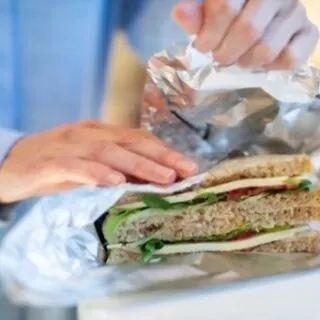
5 Best Aluminum Foil Substitutes to Consider
Ingredients
- 1 – Parchment Paper
- 2 – Silicone Baking Sheets
- 3 – Wax Paper
- 4 – Cedar Wraps for grilling
- 5 – Beeswax Food Wraps
Instructions
- Choose your preferred substitute from the list of options.
- Organize all of your ingredients.
- Use the proper substitute to cook your recipes.

Carrie is a food writer and editor with more than 15 years of experience. She has worked for some of the biggest names in the food industry, including Bon Appétit, Food & Wine, and Martha Stewart Living.
As the Editor in Chief of IntroChicago.com, Carrie oversees all of the content on the site. She also manages the team of contributing writers and editors, who help to create delicious recipes, helpful tips, and informative articles that you’ll find on the site.
A native of the Chicago area, Carrie is passionate about all things food. She loves trying new restaurants and experimenting with new recipes in her kitchen. She’s also a graduate of the Culinary Institute of America, so she knows a thing or two about food!
